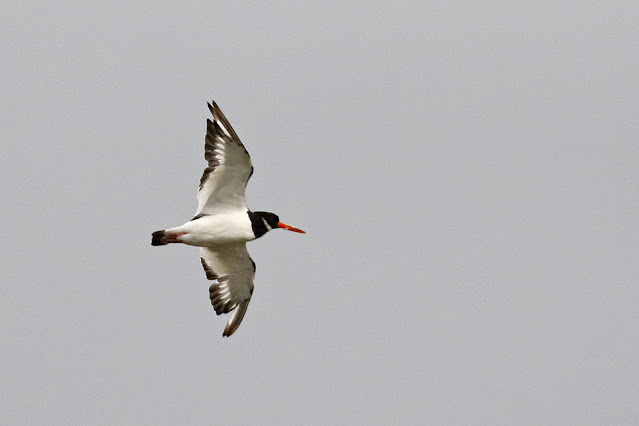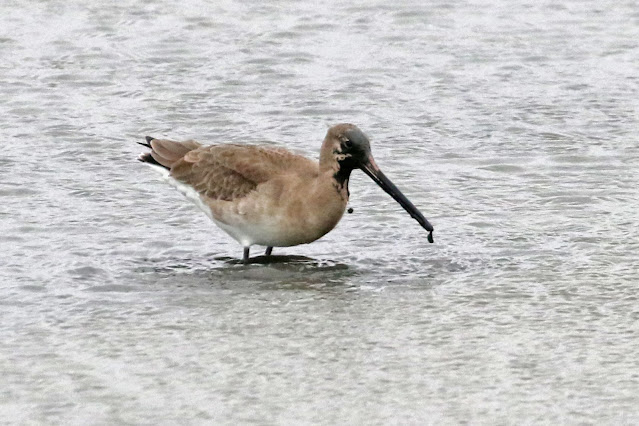We are now hours away from the end of British Summer Time, sunrise today was around 7:45, but Ian and I met in the car park at Farlington Marshes just after 7:00. The weather forecast was not good for the day, the best supposed to be first thing, but on the way here it was drizzling, and there were spots of rain as we left the carsHeavy rain and strong winds were forecast for the afternoon and we were hoping an early start here would allow us some birding before having to probably shelter in a hide in the afternoon. A Short-eared Owl had been reported from the marshes and again the hope was that despite the wind we could catch up with it.
Walking along the sea wall towards the Lake the wind felt very strong. The tide was just beginning to drop and there was a group of duck on the Lake, mostly Pintail but with a few Wigeon. I scanned the marsh beyond the lake and caught site of a light bird in the murk, it was flying around and hovering. Convinced it was a Short-eared Owl I got Ian onto itand we confirmed the identification, now could we get closer.
We left the Lake at pace and walked around the sea wall. We caught up with it again on the bank of a pool, it was closer, but still in the murk. It dropped from the bank out of sight, and then appeared a few minuted later all the way over towards the Deeps. We watched as it was mobbed by Crows, but then dropped out of sight once again in the many gulleys on the marsh.
We decided to make our way to Point Field, and fought our way through the bramble, as if in a scene from Sleeping Beauty, to get to a gate that over looks the marsh. As we reached the gate the rain and drizzle started up again. Curlew flew over the marsh and every so often the Wigeon and Teal would fly up and circle, once such event though we because of the presence of a Peregrine that made its way across the marsh towards the A27.
With the rain and wind increasing the likelihood of seeing the owl again was slipping away and we finally decided to leave and walk around to the Lake. There was a window in the weather and the sun popped through as we walked to the view point.
The tide was dropping and out in the main channel two Sandwich Terns in winter plumage fished the water.
A squall came through and we sheltered by the side of the sluice at the Lake. The water level was very high and the duck that had been present earlier had gone and the re was only a few Pintail and a good number of Teal around the edge of the water. We were looking for Snipe and there were at least 36 present in amongst the Teal and on the cut reeds at the back of the lake. The snipe we were hoping for though was a Jack Snipe, the smaller cousin of the common Snipe. It was gloomy but as a small bird flew to the reeds I followed it with the scope and picked it up as it appeared at the edge of the reeds. As I watched it the bird bobbed, the tail pushing upwards as it moved around the cut reed stems. It was much to dim and far for a photograph, but I was certain it was the hoped for Jack Snipe.
The problem was getting Ian onto the snipe, and I couldn't really help him. The light gradually improved but the Jack Snipe disappeared, and never returned despite some searching through the Common Snipe.
After awhile we decided to go for a walk around the reserve before the rain came. Walking alongside the stream we were surprised to see a Fieldfare fly up from a small stream that ran down to the main one. It circled around and landed on one of the hawthorn bushes and like all good thrushes managed to position itself behind one of the branches.
At the Information Hut a raptor appeared from across the road and headed towards us. At first the call was Marsh Harrier, but as it came closer and hovered over the field the doubts came.
Then as it headed towards and flew up into a tree it was clear it was a Buzzard.
We walked around the sea wall with very little about. Out in the main channel up to six Great crested Grebe, and on the mud Grey Plover, Redshank, Dunlin and Ringed Plover. Out on the marsh there were good numbers of Canada Geese, and in amongst them a very white goose and a single Barnacle Goose. Brent Geese were on the marsh and water and could be heard flying over between the two.
After lunch we headed for Titchfield Haven, with the weather closing in a hide would be a welcome way to spend the afternoon. As we registered at the visitor centre we were told that the reserve would probably close mid afternoon because of concerns over the Wind and the safety of visitors. We made our way to the Meon Shore Hide which was empty, sat down and hoped that something special would drop in.
I made my mid up to experiment with the camera setting and try to get some shots of the birds in flight. First a duck Teal flew past the hide.
Then I turned attention to the many Oystercatchers that were occupying one of the islands on the scrape. They would move between the scrape and the shore, and would fly over the hide as they did so.
You can see some signs of the moult in the primary feathers.
Black-tailed Godwits fed with that stitching action in the shallow water and would come up with the black mud all over the head.
Another flight shot, this time a Little Egret circling the scrape.
A pair of Golden Plover flew low over the scrape, coming in from the north, as they attempted to settle on the island with the Oystercatchers they unsettled the Starling and flew up and circled around again before settling on another adjacent island.
As always the Lapwing were very flighty, but also seemed to be enjoying the strong wind and would put in some incredible aerobatic displays over the scrape, twisting and turning with incredible skill. The Lapwing to would sometimes look to land on the birds feeding in the water. It was not clear if this was aggression or the fact that they thought it was a post or island to land on. This Redshank was not very happy as the Lapwing dropped in.
Shoveler were feeding on the surface of the water, moving between the north and south scrape. Here a drake flys in with its feet extended to aid the landing.
With little about you tend to concentrate on the behaviour in front of you and I was fascinated by the feeding behaviour of the Shoveler. The large bill lies on the surface of the water and they suck the water through, filtering out any nutrients and pushing the water out at the back of the bill.
Here close in you can see the water coming out at the back of the bill.
Three Snipe flew into the island close to the hide, one appeared at the top of the island.
While another crept around the island feeding in the mud at the base of the vegetationBack in the air, a Common Gull flew through the reserve.
Then for no reason all the Lapwing went up, taking the Godwits with them.
And a chance to photograph the Lapwing.
Then the Teal were unnerved by the Lapwing.
A Buzzard flew in from the west side and at first low over the scrape, then gained height as the waders went up.
It settled on a post on the other side of the scrape, but then returned putting the Lapwing up once again
With the Buzzard flying over the other waders went up, circled and then returned once they realised there was nothing to panic about. Here Black-tailed Godwits.
But it was the Lapwing that provided the best opportunity for the camera as they circled the scrape.It would be wrong to dismiss the day as I managed two year ticks and a county tick in the Jack Snipe. The weather wasn't the best and we had to leave the hide as the reserve closed at around 15:00. Any day with a Short-eared Owl has to be a good day, but I suppose the views we had were not brilliant, and you always want to have that killing opportunity. Still there will be more opportunities I am sure.

































No comments:
Post a Comment